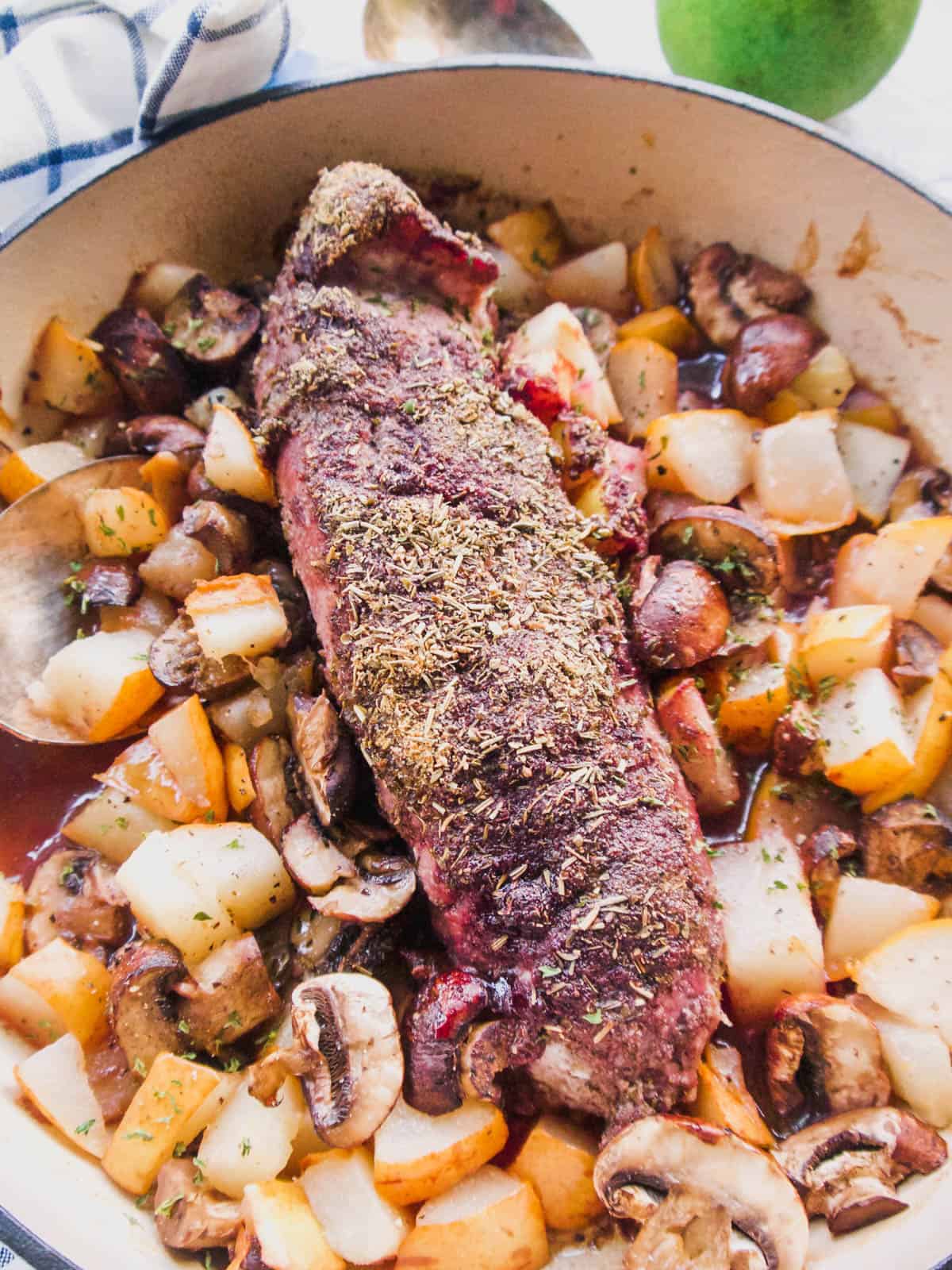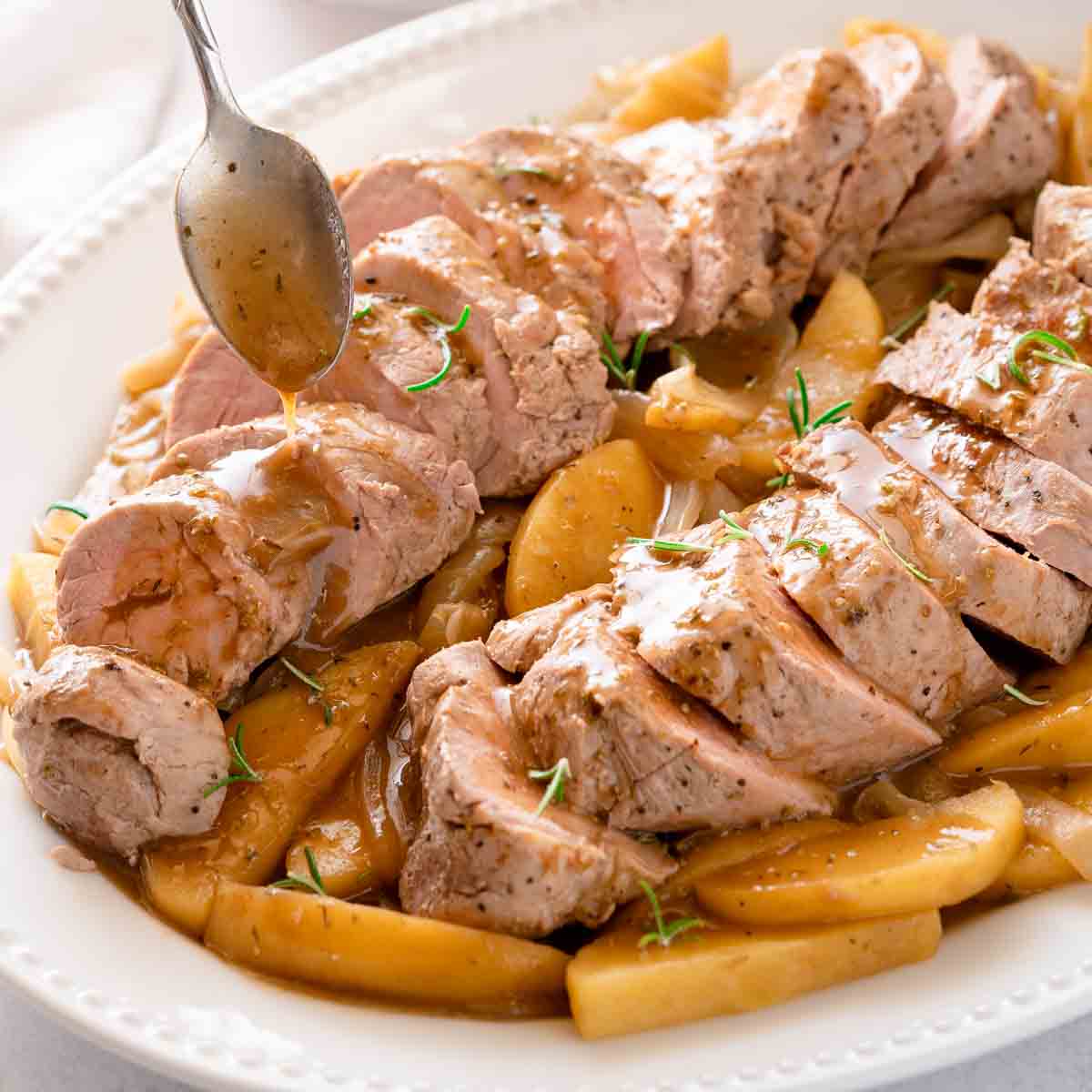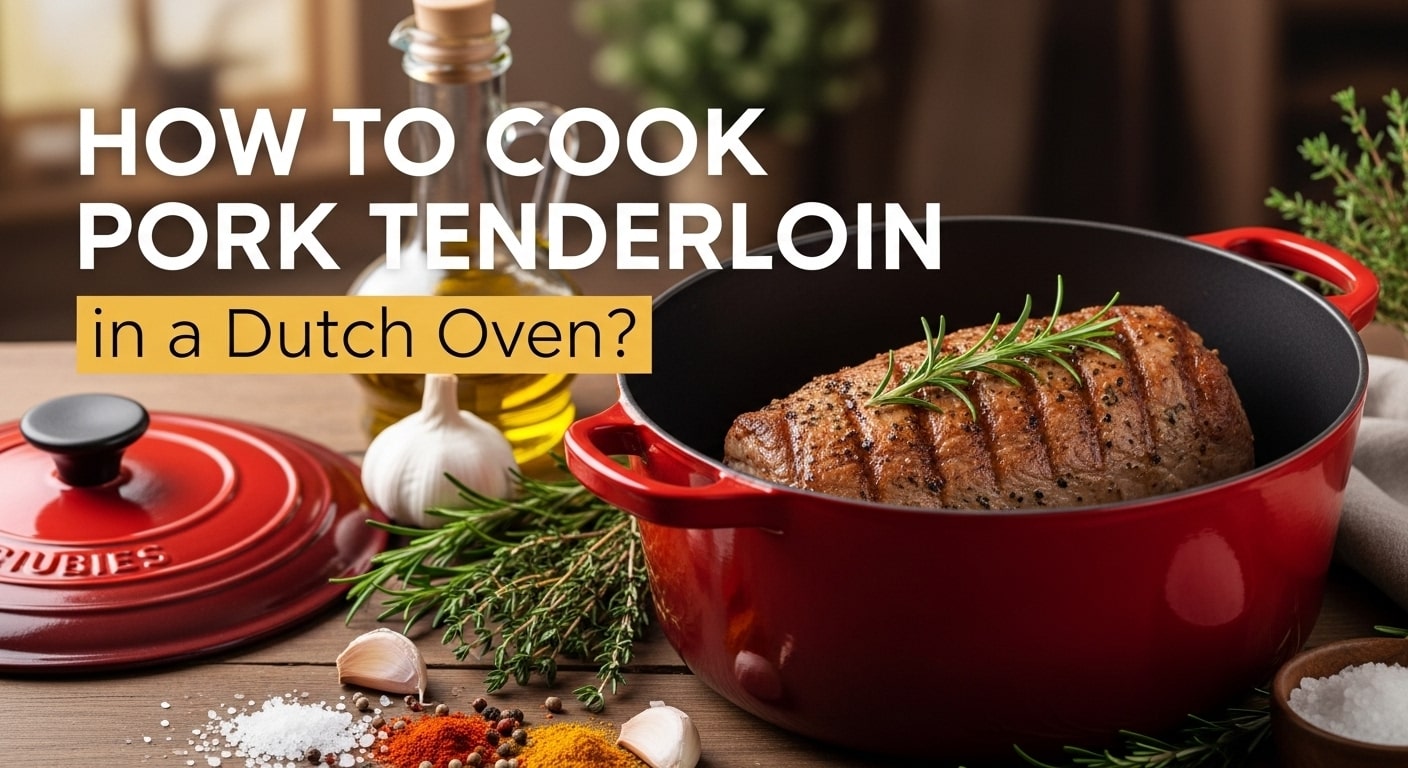Are you ready to elevate your culinary skills and impress your family and friends? Cooking pork tenderloin in a Dutch oven is not only a delicious choice but also a surprisingly simple one.
Picture this: a juicy, perfectly cooked piece of pork with a crispy outer layer, infused with mouth-watering flavors. It’s the kind of dish that makes your taste buds dance and leaves everyone at the table begging for seconds. You don’t need to be a master chef to achieve this masterpiece.
With the right technique and a trusty Dutch oven, you can create a meal that’s both elegant and comforting. Imagine the aroma wafting through your kitchen as the tenderloin slowly cooks to perfection, filling your home with warmth and anticipation. Curious to learn how you can make this delectable dish part of your cooking repertoire? Stick around, because we’re about to dive into the step-by-step process that will transform your dinner from ordinary to extraordinary. Your taste buds will thank you, and your guests will be singing your praises. Let’s get started!
Choosing The Right Pork Tenderloin
Choosing the right pork tenderloin is crucial for a delicious dish. Each cut has unique qualities that affect flavor and texture. By selecting wisely, you ensure a tender and flavorful meal.
Consider The Size
Opt for tenderloins that weigh between one to two pounds. This size cooks evenly and retains moisture. Small cuts dry out quickly, while larger ones may stay undercooked.
Examine The Color
Look for pork that has a pinkish hue. This color indicates freshness and proper handling. Avoid tenderloins with gray or dull appearance.
Check For Marbling
Marbling adds flavor and tenderness to the meat. Choose cuts with visible fat streaks. They enhance taste and ensure a juicy result.
Consider The Packaging
Ensure the packaging is intact and free from damage. Broken seals can compromise quality. Properly sealed packs maintain freshness.
Look For Certification
Check for labels indicating organic or pasture-raised meat. These certifications often mean higher quality. They ensure humane and healthy production practices.
Choose A Reputable Source
Purchase pork from trusted butchers or markets. They often provide superior cuts. Avoid unknown sources for assurance of quality.
Think About Flavor Profiles
Consider the flavor you desire in your dish. Some tenderloins have a stronger taste. Others are mild and versatile.
Selecting The Perfect Dutch Oven
Cooking pork tenderloin in a Dutch oven brings rich flavor to your table. Choosing the right Dutch oven impacts your dish’s taste and texture. Ensure your Dutch oven complements your cooking style and kitchen needs.
Size And Capacity
Consider the size of your Dutch oven. A larger pot allows more space for your pork tenderloin. It also accommodates vegetables and sauces. Opt for a size that suits your family or guests.
Material Matters
Cast iron Dutch ovens are popular for even heat distribution. They retain heat well, ensuring your pork cooks evenly. Enamel-coated options are easy to clean and add a splash of color.
Weight And Handles
Heavy pots can be challenging to lift. Ensure the handles are sturdy and easy to grip. This helps when moving the Dutch oven from stove to oven.
Lid Fit And Seal
A well-fitting lid locks in moisture. It keeps your pork tenderloin juicy and tender. Check the seal to ensure steam doesn’t escape during cooking.
Budget And Brand
Consider your budget before purchasing. Renowned brands offer durability but may be costly. Compare options to find one that balances quality and price.
Versatility In Cooking
Choose a Dutch oven that suits various cooking methods. It should be oven-safe and stovetop-friendly. This versatility expands your culinary possibilities.
Essential Ingredients
Cooking pork tenderloin in a Dutch oven brings out its rich flavors. Key ingredients make this dish a delight to prepare. Each component plays a crucial role in the taste and texture. Let’s explore these essential ingredients.
1. Fresh Pork Tenderloin
The star of the dish is fresh pork tenderloin. Choose a cut that is tender and juicy. The quality of pork directly affects the meal’s taste.
2. Olive Oil
Olive oil helps in browning the meat. It adds a subtle richness to the dish. Use extra virgin olive oil for the best flavor.
3. Garlic Cloves
Garlic infuses the pork with a robust aroma. Crush them for more flavor. They enhance the savory taste of the tenderloin.
4. Rosemary Sprigs
Rosemary adds a touch of earthiness. Its fragrance complements the pork well. Use fresh sprigs for maximum flavor.
5. Salt And Pepper
Season the pork with salt and pepper. Simple spices that enhance the meat’s natural taste. Adjust them according to preference.
6. Chicken Broth
Chicken broth keeps the pork moist. It adds depth to the flavors. Use low-sodium broth for a healthier choice.
7. Onion
Onions add sweetness to the dish. Slice them thin for better integration. Their flavor melds beautifully with the pork.
8. Lemon Juice
Lemon juice adds a hint of acidity. It balances the richness of the pork. A squeeze is enough to brighten up the dish.
Preparing The Pork Tenderloin
Cooking pork tenderloin in a Dutch oven creates tender, juicy meat. Brown the meat on all sides first. Then, simmer with your favorite herbs and spices until fully cooked.
Cooking pork tenderloin in a Dutch oven is a delightful experience that promises tender and flavorful results. The secret to achieving this lies in your preparation technique. Preparing the pork tenderloin is not just about getting the meat ready for cooking; it’s about setting the stage for a mouthwatering meal. Let’s dive into the essentials of trimming excess fat and seasoning techniques to ensure your dish is a success.
Trimming Excess Fat
Before you start, take a closer look at your pork tenderloin. You might notice some excess fat or silver skin. Trimming these off is crucial. Removing excess fat ensures your meat cooks evenly, avoiding greasy bites. Use a sharp knife to carefully trim away the fat, but be mindful not to remove too much. Consider this: a little fat can enhance flavor, so don’t strip the meat completely. Strike a balance between trimming and preserving flavor.
Seasoning Techniques
Seasoning is where your creativity shines. Basic salt and pepper are classic, but why not experiment? Consider adding garlic powder, paprika, or even a hint of cayenne pepper for a kick. The trick is to coat the tenderloin evenly for a consistent taste. Have you ever tried marinating your tenderloin overnight? This can infuse the meat with flavors that penetrate deeply. A simple mixture of olive oil, lemon juice, and herbs can transform your dish. Think about what flavors excite you. Your choice of seasoning can make the dish uniquely yours.
Preheating The Dutch Oven
Preheating the Dutch oven ensures even cooking for pork tenderloin. This step seals in flavors and keeps the meat juicy. A warm Dutch oven enhances the tenderness and taste of the pork.
Cooking pork tenderloin in a Dutch oven is a delightful experience, especially when you know the secret to tender, flavorful meat lies in the preheating process. Preheating your Dutch oven is crucial to achieving the right texture and taste. It allows the meat to sear perfectly, locking in juices and flavors from the start. Plus, it speeds up the cooking process, making it ideal for those evenings when time is of the essence.
Why Preheat The Dutch Oven?
Preheating ensures that your pork tenderloin starts cooking immediately upon contact. It helps to create a beautiful, caramelized crust. This initial sear is key to a tender inside. By preheating, you avoid a soggy texture and keep the flavors intact.
Step-by-step Guide To Preheating
Begin by placing your Dutch oven on the stovetop. Set the heat to medium. Allow it to warm for about 5-10 minutes. You can test its readiness by flicking a drop of water inside; it should sizzle instantly. This indicates the surface is hot enough for searing.
Tools You’ll Need
Having the right equipment makes a difference. Use a sturdy pair of tongs to handle your pork tenderloin. A reliable meat thermometer is also helpful. It ensures your meat reaches the perfect internal temperature.
Personal Tips For Success
From my experience, patience is key. Resist the urge to rush the preheating process. Waiting the full duration guarantees better results. I once cut corners and ended up with unevenly cooked pork. It taught me the value of patience in cooking.
Frequently Asked Questions
Do you wonder if skipping preheating affects your dish? Yes, it does. You might end up with meat that’s more boiled than seared. Is your Dutch oven seasoned? If not, preheating helps build a natural non-stick surface over time. By focusing on preheating, you set the stage for a memorable meal. It’s a simple step that can transform your cooking. Are you ready to try it and taste the difference?

Credit: perchancetocook.com
Searing The Pork Tenderloin
Searing the pork tenderloin in a Dutch oven creates a delicious, golden-brown crust. This step locks in juices and flavors, enhancing the meat’s taste. Follow with slow cooking for a tender, mouthwatering dish.
Searing the pork tenderloin is a vital step that elevates your dish from ordinary to extraordinary. This technique locks in juices, creating a deliciously crispy crust that contrasts beautifully with the tender meat inside. If you’ve ever wondered how professional chefs achieve that mouthwatering flavor and texture, searing is the secret.
What You’ll Need For Searing
Before you begin, gather your essentials. A Dutch oven, a pair of tongs, and some olive oil are your best friends here. Make sure your pork tenderloin is at room temperature for even cooking. Season it generously with salt and pepper to enhance the natural flavors.
Preheat The Dutch Oven
Place your Dutch oven on the stove over medium-high heat. You’ll know it’s ready when a few drops of water sizzle upon contact. This step ensures that the pork develops a golden-brown crust.
Add Oil To The Dutch Oven
Pour in a tablespoon of olive oil and swirl it around. You want just enough to coat the bottom. This prevents the meat from sticking and helps achieve that perfect sear.
Sear The Pork Tenderloin
Gently lay the pork tenderloin in the hot Dutch oven. Avoid overcrowding; if necessary, sear in batches. Allow each side to cook for about 2-3 minutes until a rich, brown crust forms. Resist the urge to move it around; patience is key.
Check The Crust
Use your tongs to lift the pork slightly and check the crust. It should be a deep, caramelized brown. If it’s not quite there, give it another minute or two. This is crucial for flavor, so don’t rush it.
Why Searing Matters
Searing creates a Maillard reaction, which is a chemical process that adds depth and complexity to your dish. Have you ever noticed how grilled meats have a unique taste? That’s the Maillard effect at work. It’s not just about appearance; it’s about building layers of flavor that make every bite more satisfying.
Common Mistakes To Avoid
Avoid using a cold pan or overcrowding the Dutch oven. These can lead to steaming instead of searing. Also, don’t turn the pork too soon; let it develop that crust. Have you ever tried searing before? What challenges did you face? Searing is more than just a step; it’s an art form that can transform your cooking. By mastering this technique, you’re well on your way to creating a memorable pork tenderloin that will impress everyone at the table.
Adding Aromatics And Liquids
Cooking pork tenderloin in a Dutch oven creates a delightful meal. Adding aromatics and liquids elevates the dish further. This step infuses the meat with rich flavors. It also keeps the pork tender and juicy. Understanding the right aromatics and liquids can transform your dish.
Choosing The Right Aromatics
Aromatics are essential for flavor. Garlic, onions, and herbs are great choices. They add depth and aroma. Slice onions thinly for even cooking. Crush garlic cloves to release oils. Fresh herbs like thyme or rosemary work best. These ingredients create a flavorful base.
Selecting The Perfect Liquids
Liquids help cook and flavor the pork. Broth, wine, or apple juice are good options. They keep the meat moist. Choose chicken or vegetable broth for a savory taste. White wine adds a subtle tang. Apple juice gives a hint of sweetness. Ensure the liquid covers the bottom of the Dutch oven.
Combining Aromatics And Liquids
Layer aromatics at the bottom of the Dutch oven. This prevents burning and enhances flavor. Pour the chosen liquid over the aromatics. This ensures even cooking. The combination of aromatics and liquids creates a flavorful steam. This infuses the pork as it cooks.
Timing And Temperature
Cooking pork tenderloin requires precision. Set your oven to a moderate temperature. Around 350°F works well. Check the liquid level often. Add more if needed. Cook the pork until the internal temperature reaches 145°F. This ensures it’s juicy and safe to eat.
Final Touches
Let the pork rest after cooking. This step is crucial for tenderness. Slice the tenderloin and serve with the cooking liquids. The flavors will be rich and satisfying. Aromatics and liquids make a difference in this dish. Enjoy a delicious meal with every bite.
Cooking To Perfection
Cooking pork tenderloin to perfection in a Dutch oven is an art. This method promises juicy and flavorful results. The Dutch oven’s even heat distribution creates a deliciously tender dish.
Monitoring Temperature
Temperature control is key. A meat thermometer is your best friend. Insert it into the thickest part of the pork. Aim for an internal temperature of 145°F (63°C). This ensures the pork is safe and juicy.
Timing And Tenderness
Cooking time affects tenderness. Slow cooking enhances flavors and keeps the pork tender. Typically, pork tenderloin takes 20-25 minutes per pound. This varies with oven temperature and pork size.
Check for doneness frequently. Overcooking makes the pork dry. A perfectly cooked tenderloin should be juicy and flavorful.
Resting The Meat
Letting pork tenderloin rest after cooking in a Dutch oven locks in its juices. This step enhances flavor and tenderness. Resting allows the meat fibers to relax, making each bite delicious.
Resting the meat is a crucial step in cooking pork tenderloin in a Dutch oven that many home cooks overlook. It allows the juices to redistribute, making your pork tenderloin tender and flavorful. If you’ve ever sliced into a roast and watched all the juices run out, you understand why resting matters.
Why Resting Makes A Difference
Resting the meat lets the fibers in the pork relax. When you cook meat, the proteins tense up, and resting gives them a chance to ease back into place. This process traps the juices inside the pork, enhancing its taste and texture. Think about the last time you were too impatient to wait and cut into the meat right away. Did it seem dry? That’s because the juices hadn’t settled. Allowing the meat to rest brings out the best flavors.
How Long Should You Rest Pork Tenderloin?
A common question is, “How long do you really need to wait?” Generally, 10 to 15 minutes is a good rule for pork tenderloin. Use this time to prepare a quick salad or set the table. You’ll be surprised at how this short wait can transform your dish. Remember, patience pays off. While it may be tempting to dig in immediately, a little patience goes a long way in achieving that perfect bite.
Tips For Resting Meat Properly
Consider using a tent of foil to cover the pork tenderloin as it rests. This keeps it warm without overcooking. Avoid tightly wrapping it, as this can cause steam and affect the texture. Place the tenderloin on a cutting board with grooves to catch any juices that escape. This way, you can drizzle them back over the meat once you slice it, adding even more flavor. Ask yourself, “Is there a way to make this step more efficient?” Perhaps using a timer could help ensure you don’t rush the process. Embrace the wait; it’s a small effort for a big reward in taste.
Personal Insight: The Resting Revelation
I once skipped resting in a hurry to serve dinner, thinking it wouldn’t matter. But the difference was clear—the meat was less juicy and flavorful. Since then, I’ve made resting a priority, and it’s consistently improved my cooking results. Can you recall a time when patience in cooking paid off? It’s these small details that elevate your dish from good to outstanding.

Credit: nibbleanddine.com
Serving Suggestions
Pork tenderloin cooked in a Dutch oven pairs wonderfully with roasted vegetables and a fresh green salad. For a cozy meal, serve with creamy mashed potatoes or crusty bread. Add a side of apple sauce for a touch of sweetness.
Cooking pork tenderloin in a Dutch oven can be a delightful experience, but what happens when it’s time to serve? This is where creativity and taste come together to elevate your dish. Whether you’re hosting a dinner party or enjoying a cozy meal at home, the right serving suggestions can transform your pork tenderloin into a memorable feast.
Accompaniments
Pairing your pork tenderloin with the right sides can create a harmonious plate. Consider serving it with roasted vegetables like carrots and Brussels sprouts. Their earthy flavors complement the tender, juicy pork beautifully. Mashed potatoes or creamy polenta are excellent choices too. They provide a comforting base and soak up the flavorful juices from the pork. A crisp salad with a tangy vinaigrette can add a refreshing contrast. It’s a great way to balance the richness of the tenderloin.
Wine Pairings
Choosing the right wine can enhance the flavors of your meal. A light Pinot Noir can be a delightful match, its fruity notes and subtle earthiness making it a versatile partner for pork tenderloin. If you prefer white wine, try a Chardonnay. Its buttery texture and hint of oak complement the pork’s savory taste. Thinking about a special occasion? Perhaps a sparkling wine could add a festive touch. Its effervescence can add a celebratory sparkle to your meal. Do you have a favorite wine that you think pairs perfectly with pork tenderloin? Experimenting with different options can lead to delicious discoveries. Remember, the right serving suggestions can turn a simple pork tenderloin into a culinary masterpiece. What will you try next time?

Credit: quichemygrits.com
Frequently Asked Questions
How Do I Prepare Pork Tenderloin For Cooking?
Begin by trimming excess fat from the pork tenderloin. Season it generously with salt, pepper, and herbs. Consider marinating it for added flavor. Ensure the pork is at room temperature before placing it in the Dutch oven for even cooking.
Can I Sear Pork Tenderloin Before Using The Dutch Oven?
Yes, searing the pork tenderloin enhances its flavor. Heat oil in the Dutch oven, then sear the pork for 3-4 minutes per side. This creates a delicious crust and locks in juices, enhancing the final dish.
What Temperature Should I Cook Pork Tenderloin To?
The ideal internal temperature for cooked pork tenderloin is 145°F. Use a meat thermometer to ensure accuracy. After reaching this temperature, let the meat rest for a few minutes. This allows juices to redistribute, ensuring a moist and flavorful result.
How Long Does It Take To Cook Pork Tenderloin?
Cooking time varies based on the size and method. Typically, it takes about 25-30 minutes at 375°F in a Dutch oven. Check the internal temperature to ensure it’s cooked properly. Resting the meat after cooking enhances its texture and taste.
Conclusion
Cooking pork tenderloin in a Dutch oven is simple and rewarding. The process enhances flavor and keeps the meat juicy. You only need a few basic ingredients and steps. Perfect for a family dinner or special occasion. Remember to let it rest before serving.
This helps keep it tender and delicious. With practice, you’ll make this dish easily. Share this recipe with friends and enjoy together. Your Dutch oven is a great tool for tasty meals. Happy cooking!


Leave a Reply